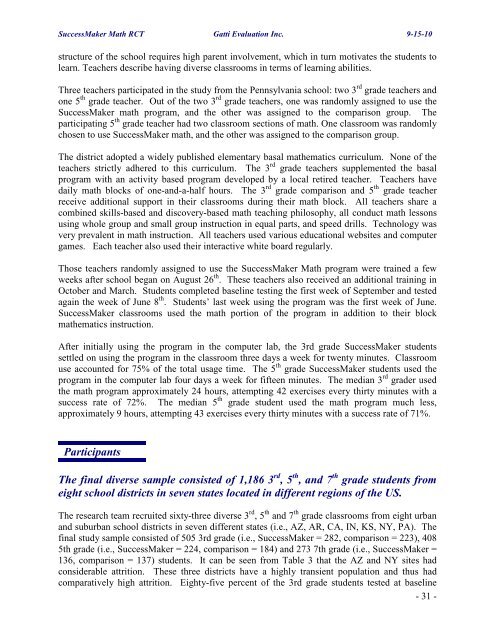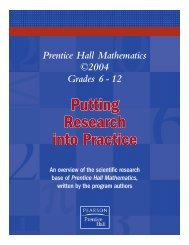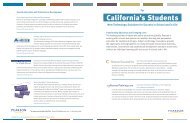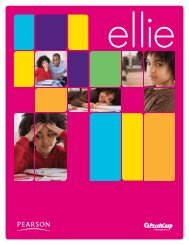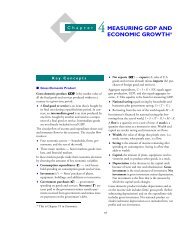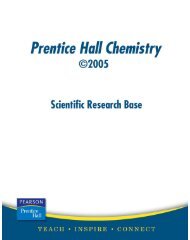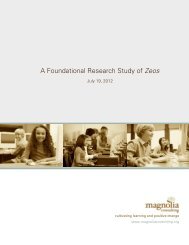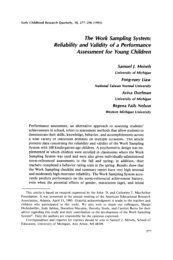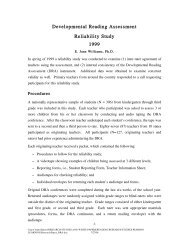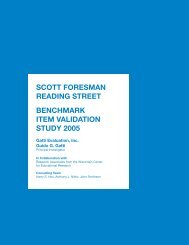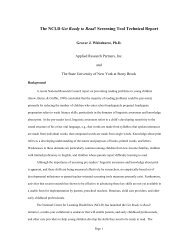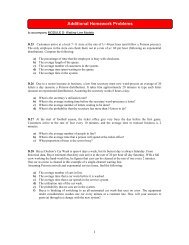Pearson Successmaker Math Efficacy Study 2009-10 Final Report
Pearson Successmaker Math Efficacy Study 2009-10 Final Report
Pearson Successmaker Math Efficacy Study 2009-10 Final Report
You also want an ePaper? Increase the reach of your titles
YUMPU automatically turns print PDFs into web optimized ePapers that Google loves.
SuccessMaker <strong>Math</strong> RCT Gatti Evaluation Inc. 9-15-<strong>10</strong>structure of the school requires high parent involvement, which in turn motivates the students tolearn. Teachers describe having diverse classrooms in terms of learning abilities.Three teachers participated in the study from the Pennsylvania school: two 3 rd grade teachers andone 5 th grade teacher. Out of the two 3 rd grade teachers, one was randomly assigned to use theSuccessMaker math program, and the other was assigned to the comparison group. Theparticipating 5 th grade teacher had two classroom sections of math. One classroom was randomlychosen to use SuccessMaker math, and the other was assigned to the comparison group.The district adopted a widely published elementary basal mathematics curriculum. None of theteachers strictly adhered to this curriculum. The 3 rd grade teachers supplemented the basalprogram with an activity based program developed by a local retired teacher. Teachers havedaily math blocks of one-and-a-half hours. The 3 rd grade comparison and 5 th grade teacherreceive additional support in their classrooms during their math block. All teachers share acombined skills-based and discovery-based math teaching philosophy, all conduct math lessonsusing whole group and small group instruction in equal parts, and speed drills. Technology wasvery prevalent in math instruction. All teachers used various educational websites and computergames. Each teacher also used their interactive white board regularly.Those teachers randomly assigned to use the SuccessMaker <strong>Math</strong> program were trained a fewweeks after school began on August 26 th . These teachers also received an additional training inOctober and March. Students completed baseline testing the first week of September and testedagain the week of June 8 th . Students’ last week using the program was the first week of June.SuccessMaker classrooms used the math portion of the program in addition to their blockmathematics instruction.After initially using the program in the computer lab, the 3rd grade SuccessMaker studentssettled on using the program in the classroom three days a week for twenty minutes. Classroomuse accounted for 75% of the total usage time. The 5 th grade SuccessMaker students used theprogram in the computer lab four days a week for fifteen minutes. The median 3 rd grader usedthe math program approximately 24 hours, attempting 42 exercises every thirty minutes with asuccess rate of 72%. The median 5 th grade student used the math program much less,approximately 9 hours, attempting 43 exercises every thirty minutes with a success rate of 71%.ParticipantsThe final diverse sample consisted of 1,186 3 rd , 5 th , and 7 th grade students fromeight school districts in seven states located in different regions of the US.The research team recruited sixty-three diverse 3 rd , 5 th and 7 th grade classrooms from eight urbanand suburban school districts in seven different states (i.e., AZ, AR, CA, IN, KS, NY, PA). Thefinal study sample consisted of 505 3rd grade (i.e., SuccessMaker = 282, comparison = 223), 4085th grade (i.e., SuccessMaker = 224, comparison = 184) and 273 7th grade (i.e., SuccessMaker =136, comparison = 137) students. It can be seen from Table 3 that the AZ and NY sites hadconsiderable attrition. These three districts have a highly transient population and thus hadcomparatively high attrition. Eighty-five percent of the 3rd grade students tested at baseline- 31 -


